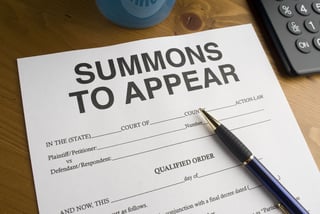 Here we will discuss what a Summons is and what you can do to protect yourself now that you’ve received one. Receiving a Summons can be terrifying, especially if this is unfamiliar territory.
Here we will discuss what a Summons is and what you can do to protect yourself now that you’ve received one. Receiving a Summons can be terrifying, especially if this is unfamiliar territory.
What is a Summons and Complaint?
A summons is the start of a lawsuit. Often, our clients receive a Summons in conciliation court. Conciliation is the legal equivalent to “Small Claims Court”. If you've received a Summons from one of your creditors, it is likely the Summons was filed in Conciliation Court. This means one of your creditors has decided to initiate a lawsuit against you for a delinquent debt.
When a creditor initiates a lawsuit against you, the creditors must deliver the Summons to you in a specific manner. This is called “Service of Process”. There are two methods in which the Summons and Complaint satisfy Service of Process: delivery to you personally, leaving it at your home with someone who is of suitable age and discretion; or by mail, if the you agree to this form of process.
Generally, you have twenty (20) days to respond to the summons. Failure to respond to the summons will result in a default judgment. A default judgment is when a judge rules in the favor of your creditor automatically because you failed to respond to the lawsuit. It is highly recommended you respond to a Summons you've received. This especially holds true if you believe the creditor is incorrect in their allegations against you and you believe there is an argument you can make to defend yourself against the lawsuit.
In looking at the summons you've received, you will see there are parties listed as “Plaintiff” and “Defendant”. The Plaintiff is the person/entity that is suing you and you are the Defendant. Along with the Summons, you will receive a Complaint. The Complaint is the legal document which outlines the argument the Plaintiff is making against you. This document will have all of the alleged facts and the basis for the Plaintiffs argument.
Responding to the Summons and Complaint
If you have been served with a Summons and Complaint, and wish to respond to the lawsuit, you must do so by serving the Plaintiff with a legal document called an Answer. In the Answer, you will make the Plaintiff aware of the issues you're contesting and any legal defenses you may have. Failure to serve an Answer on the Plaintiff within the twenty (20) day window will likely result in a Default Judgment against you.
Worst Case Scenario
In the event you've been served a Summons and Complaint, it is important you respond with an Answer. Failure to do so will result in a Default Judgment. If a Default Judgment is entered against you, a judge may authorize wage garnishment or attachment of your bank accounts. If this happens, your money will be taken away from you to satisfy the underlying liability. When wage garnishment is authorized, your wages may be garnished up to 25%. For most people, this can have a drastic impact on their finances. If a judgment has been entered against you, there are a two options available to protect you from the creditor: you can either satisfy the underlying debt by paying it off, or you can file for bankruptcy protection.
Bankruptcy Protection
Bankruptcy is a frightening thought for some people. However, despite the negative stigma society has placed on bankruptcy, the bankruptcy law which provides bankruptcy protection proves to be extremely beneficial. If you’re facing a lawsuit from a creditor, and don’t have the financial ability to satisfy the debt, bankruptcy can protect you from having to pay off the debt. Through bankruptcy, you avoid liability on most debts.
In the world of consumer bankruptcy, you have two options. You can either file for protection under Chapter 7 or Chapter 13. Depending on the specific facts of your situation, one option will be better than the other. Whichever Chapter is a better fit, the end result is the same. Once you receive your bankruptcy discharge, you are free from liability on most of your debts forever! Additionally, filing for bankruptcy can stop a civil lawsuit initiated by creditors over unpaid debts.
When you file bankruptcy, there is provision in the bankruptcy code called the Automatic Stay. The Automatic Stay is an injunction that protects you from your creditors. Once the Automatic Stay goes into effect, your creditors can no longer collect against you during the pendency of your bankruptcy. The only time creditors can collect from you during an active bankruptcy is when your creditor receives court approval; which is not common.
If the underlying debt survives the bankruptcy, your creditor will be able to continue collection activity after you have received your discharge. There are very few debts which survive bankruptcy. Typically, debts that survive bankruptcy consist of the following: some taxes, domestic support obligations, and most student loans.
What Happens If You Don't Respond to a Summons?
If you fail to respond to a summons within the specified timeframe, typically 20 days in Minnesota, the court can enter a default judgment against you. This means the plaintiff automatically wins the lawsuit, and the judge can authorize collection actions such as wage garnishment or bank account levies to satisfy the debt. Wage garnishment allows the creditor to take a portion of your paycheck, up to 25% in most cases, until the debt is paid in full. This can have a significant impact on your finances and make it even more difficult to manage your other debts.
Filing Bankruptcy After Receiving a Summons: Is It Too Late?
Even if you’ve already received a summons or a default judgment has been entered against you, it’s not too late to file for bankruptcy. Filing for bankruptcy can stop civil lawsuits initiated by creditors, preventing them from continuing their collection activities. The automatic stay will immediately halt any ongoing collection efforts, such as wage garnishment or bank account levies. It is crucial to organize your financial affairs, including your financial position, income, expenses, and repayment plan, when filing for bankruptcy. Additionally, filing for bankruptcy can potentially discharge the underlying debt, eliminating your legal obligation to repay it.
Recovering Garnished Wages Through Bankruptcy: Understanding Wage Garnishment
If your wages have already been garnished before you filed for bankruptcy, you might be able to recover those funds. The automatic stay stops any further garnishment, and the bankruptcy trustee may be able to recover the garnished funds for distribution among your creditors. However, recovering garnished wages can be a complex process, and it's essential to consult with a bankruptcy attorney to understand your options and rights.
Bankruptcy and Business Debts: Special Considerations
If you're a business debtor filing for bankruptcy, the rules regarding preferential and fraudulent transfers can be more complex. It's crucial to consult with an experienced bankruptcy attorney who specializes in business bankruptcy to understand how these rules apply to your specific situation.
Understanding the Statute of Limitations for Debt Collection
Each state has a statute of limitations, which is a time limit for creditors to sue you for unpaid debts. In Minnesota, the statute of limitations for most consumer debts is six years. This means that if a creditor waits longer than six years to sue you, you might have a legal defense based on the statute of limitations. However, it's important to note that the statute of limitations can be extended in certain circumstances, such as if you made a partial payment on the debt or acknowledged the debt in writing.
The Role of the Bankruptcy Court in Protecting Your Rights
The bankruptcy court plays a vital role in overseeing the bankruptcy process and ensuring that both debtors and creditors are treated fairly. The court manages the bankruptcy estate, which involves overseeing the distribution of assets to creditors. The court has the authority to grant a bankruptcy discharge, which releases you from most of your debts, and to prevent creditors from violating the automatic stay. If you believe a creditor has violated the automatic stay, you can file a motion with the court requesting sanctions against the creditor.
Avoiding Collection Activity Through Bankruptcy
Filing for bankruptcy can be a powerful tool for stopping collection activity and getting a fresh financial start. However, it's important to understand that bankruptcy is not a magic solution. It won't eliminate all types of debt, such as child support, most student loans, and certain taxes.
Before filing for bankruptcy, it's crucial to consult with an experienced bankruptcy attorney to discuss your options and develop a plan that aligns with your financial goals. A bankruptcy attorney can help you understand the benefits and drawbacks of bankruptcy, navigate the complex legal process, and protect your rights throughout the case.
Protecting Your Financial Future: The Importance of Legal Counsel
While this comprehensive guide provides a wealth of information about how bankruptcy can protect you from a summons to appear in court, it's important to remember that it's not a substitute for legal advice. Every bankruptcy case is unique, and the specific laws and procedures can vary depending on your jurisdiction and individual circumstances.
Therefore, if you're facing a lawsuit or considering bankruptcy, consulting with a qualified bankruptcy attorney is essential. They can provide you with personalized guidance, protect your rights, and help you achieve a successful outcome in your bankruptcy case. Don't hesitate to seek legal counsel to ensure the best possible outcome for your financial future.
How Bankruptcy Helps
As mentioned, once bankruptcy is filed, your creditors cannot continue collection activity against you during the pendency of the bankruptcy. The bankruptcy estate is managed by a trustee who oversees the distribution of assets to unsecured creditors. Once you receive your discharge, you are free from most debts. So, if you have received a Summons and Complaint for a past due bill (i.e. credit cards, vehicle repossession, etc.), and subsequently file bankruptcy, the Summons and Complaint gets dismissed. Once the Summons is dismissed, you no longer have to worry about a pending judgment. And, best of all, your obligation on the underlying debt is discharged with the bankruptcy.
Organizing your financial affairs is crucial when filing for bankruptcy. Whether you are within the twenty (20) day window after being served or not, bankruptcy will likely protect you from the underlying debt. If a judgment has been entered against you and the creditor has started to garnish your wages, we can still help this come to an end. Once your bankruptcy is filed, the creditor must cease garnishments. Any amounts that are garnished after your case is filed can be returned to you.
If a judgment has been entered before your bankruptcy is filed, there are additional steps that will need to be taken to have the judgment removed from your record. Once you receive your bankruptcy discharge, we can walk you through the process of getting this taken care of. If you file bankruptcy through our office, we have a 90 day credit repair program designed to help clear up your credit after receiving a discharge.
At LifeBack Law firm, we don’t judge you, we help you get your life back. Feel free to give us call and schedule a free consultation with one of our MN Bankruptcy Attorneys.






